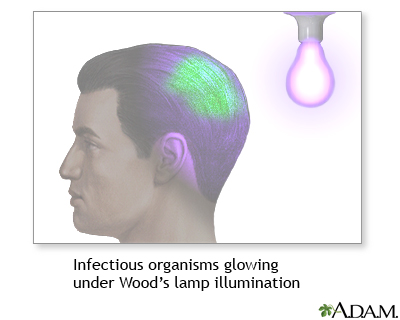Health Library
Wood lamp examination
Black light test; Ultraviolet light test
A Wood lamp examination is a test that uses ultraviolet (UV) light to look at the skin closely.
Images


I Would Like to Learn About:
How the Test Is Performed
You sit in a dark room for this test. The test is usually done in a skin doctor's (dermatologist's) office. The doctor will turn on the Wood lamp and hold it 4 to 5 inches (10 to 12.5 centimeters) from the skin to look for color changes.
How to Prepare for the Test
You do not need to take any special steps before this test. Follow your doctor's instructions about not putting creams or medicines on the area of the skin before the test.
How the Test will Feel
You will have no discomfort during this test.
Why the Test Is Performed
This test is done to look for skin problems including:
- Bacterial infections
- Fungal infections
- Porphyria (an inherited disorder that causes rashes, blistering, and scarring of the skin)
- Skin coloring changes, such as vitiligo and some skin cancers
Not all types of bacteria and fungi show up under the light.
Normal Results
Normally the skin will not shine under the ultraviolet light.
What Abnormal Results Mean
A Wood lamp exam may help your doctor confirm a fungal or bacterial infection or diagnose vitiligo. Your doctor may also be able to learn what is causing any light- or dark-colored spots on your skin.
The following things can change the results of the test:
- Washing your skin before the test (may cause a false-negative result)
- A room that is not dark enough
- Other materials that glow under the light, such as some deodorants, make-up, soaps, and sometimes lint
Risks
DO NOT look directly into the ultraviolet light, as the light may harm the eye.
Related Information
PorphyriaRingworm of the scalp
References
Dinulos JGH. Light-related diseases and disorders of pigmentation. In: Dinulos JGH, ed. Habif's Clinical Dermatology: A Color Guide to Diagnosis and Therapy. 7th ed. Philadelphia, PA: Elsevier; 2021:chap 19.
Spates ST. Diagnostic techniques. In: High WA, Prok LD, eds. Dermatology Secrets. 6th ed. Philadelphia, PA: Elsevier; 2021:chap 3.
BACK TO TOPReview Date: 11/30/2022
Reviewed By: Ramin Fathi, MD, FAAD, Director, Phoenix Surgical Dermatology Group, Phoenix, AZ. Also reviewed by David C. Dugdale, MD, Medical Director, Brenda Conaway, Editorial Director, and the A.D.A.M. Editorial team.
 | A.D.A.M., Inc. is accredited by URAC, for Health Content Provider (www.urac.org). URAC's accreditation program is an independent audit to verify that A.D.A.M. follows rigorous standards of quality and accountability. A.D.A.M. is among the first to achieve this important distinction for online health information and services. Learn more about A.D.A.M.'s editorial policy, editorial process and privacy policy. A.D.A.M. is also a founding member of Hi-Ethics. This site complies with the HONcode standard for trustworthy health information: verify here. |
The information provided herein should not be used during any medical emergency or for the diagnosis or treatment of any medical condition. A licensed medical professional should be consulted for diagnosis and treatment of any and all medical conditions. Links to other sites are provided for information only -- they do not constitute endorsements of those other sites. © 1997- 2023 A.D.A.M., a business unit of Ebix, Inc. Any duplication or distribution of the information contained herein is strictly prohibited.
